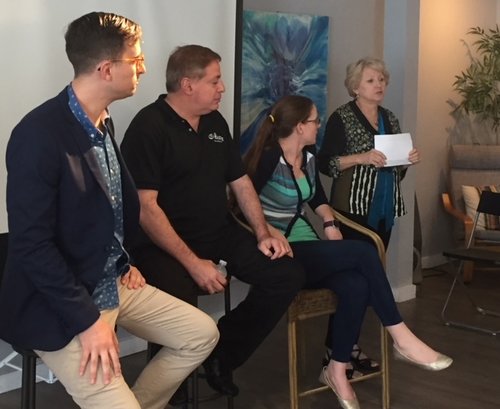by Jim Hornickel
The second most common thing that people are afraid of is death. The number one fear is public speaking. Really, people would rather die than make a presentation.

Have you ever been at a gallery opening and been asked to speak on the spot? Or perhaps you agreed to do a talk and actually have some time to prepare. Either way, you want to be effective and positively persuasive, right? This counts whether your “audience” is one person or 100.
There are two main factors to being a powerful, influential presenter: comfort and skill. And, if worked on correctly, they go hand in hand. What follows are five important areas that will need your attention. The caveat is this… they really need to be worked on and practiced. Presenting is one skill area where being self-taught doesn’t work well. It will be best if you get a presentation coach, attend a live class and/or join a group like Toastmasters. Here are the top five presentations skill areas:
Know Your Audience
The easiest way to think about this is based on the four quadrant behavioral style models (there are many). Here’s the reason behind this. People vary (in these four ways and more), and if you do not present to them in a way that is most comfortable and familiar to them, they will not take your message in very deeply.
You probably have a dominant behavior style. And you probably present from that style. But let’s say that you may like to give the big picture while some of your audience will want lots more detail. Or you may be an expresser (facial variety, gestures, multi-toned) but your audience is much less demonstrative. You are a mismatch. And mismatches are ineffective.
So, it is really worth studying behavioral styles as part of skilling up for presentations.
Use a Strong Opening Structure
Getting started can be hard. And if you are having a hard time, so will your audience. Setting direction for your topic is critical so that people can follow along. And given what we said about varying behavioral styles, people follow along in different ways. So you need an opening structure that not only keeps you focused (thereby reducing nerves), but that hooks different people with different presentation preferences. You must constantly engage and reengage your audience, and a well-designed opening will start you off on the right track. No worries. The class you attend or your presentation coach will help with this.
Vary Your Voice
One way to continually hook your audience is through your voice. There are four basic aspects to voice: pitch, pace, pause and projection. With practice and purposefulness, you can animate your words to great effect. What do you want to highlight as you speak? Is there anything particular you want your audience to retain? What key words or keyword phrases do you want to stick in the minds of those you are with? Your voice will enter the mind of the receivers and either deaden the effect or create waves of neural interest.
The ups and downs of pitch add interest; shows you have interest. You can speed up your pace to show excitement or slow it down to stress some important feature of your art. A moment of silence with pause lets them take in something you said. And using projection, speaking louder or softer creates the mood you want. Master these four through coaching and practice and you have much more influence. Having more influence gives you more confidence.
Highlight with Your Body
Sixty percent of what people believe comes through what they see. How you purposefully use your facial expressions, hand & arm gestures and your body all contribute to full communication. What people see in your piece of art is a wonderful start and, you can enhance viewers experience or the sale of your work through powerful presentations. And the visual you, how you look in presenting, can either make or break how receptive people are to you, and therefore to your work.
The most informative tool in getting presentation training is to be video recorded. But this is best done in the hands of a presentation specialist who can point out what is distracting (therefore detracting from your message) or what is enhancing for your audience. The better you get, the more comfortable you feel.
Connect with Engagement Devices
Many listeners get bored or distracted quickly. How do you keep them tuned in? Different behavior styles like different engagement devices. Those we call “Doers” like strong Quotes from authorities. “Thinkers” like detailed Statistics. “Talkers” like a relevant Story. “Guardians” feel better when hearing examples of others who have liked your work. Pepper your presentation with engagement devices to bring your message to life.
The bottom line is this: Presenting is not rocket science. There are a series of techniques that can be learned; and you can learn them. There are training/coaching allies who can help you eliminate weakening distractions. Just as you first learned the basics of your art and them slowly mastered them, taking time to incrementally grow your presentation skills will make a huge difference in getting your art appreciated and sold.
What’s your experience speaking about your work in front of an audience? Please share tips, observations and horror stories!
 Guest blogger Jim Hornickel has many years of experience training businesspeople in leadership, teamwork and communication skills. He agreed to address how artists can better speak about their work and improve their confidence. Visit his website for more information on presentation training.
Guest blogger Jim Hornickel has many years of experience training businesspeople in leadership, teamwork and communication skills. He agreed to address how artists can better speak about their work and improve their confidence. Visit his website for more information on presentation training.


I know an artist who was giving her very first presentation in front of a public art panel. She did three test presentations in her studio, by inviting other artists, curators and public art folks to be in her “audience”. She then asked us for feedback. Her first presentation was not so great, but she listened to all the feedback and she won the commission. It never hurts to practice!
Your friend was smart to be so prepared. How many times have you stood tongue-tied because your mind went absolutely blank at the crucial moment? Thanks for your comment. Practice does make perfect!
Awesome! I have never thought about to “highlight with the body”. Very strong idea! Thanks for sharing!